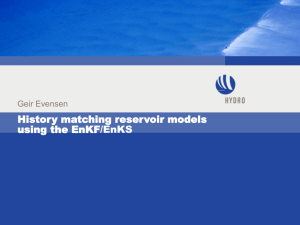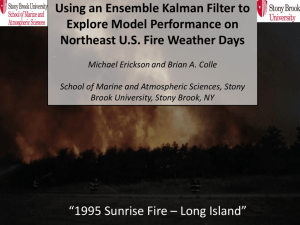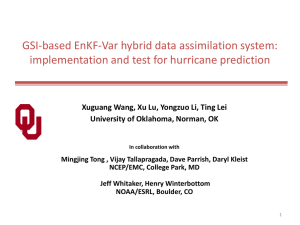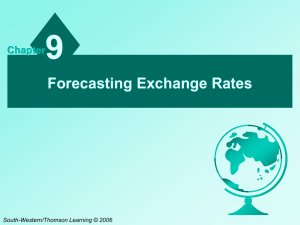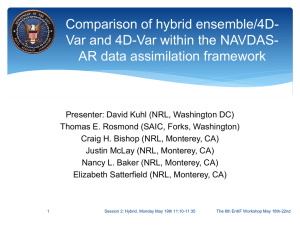Operational Forecasting and Sensitivity
advertisement
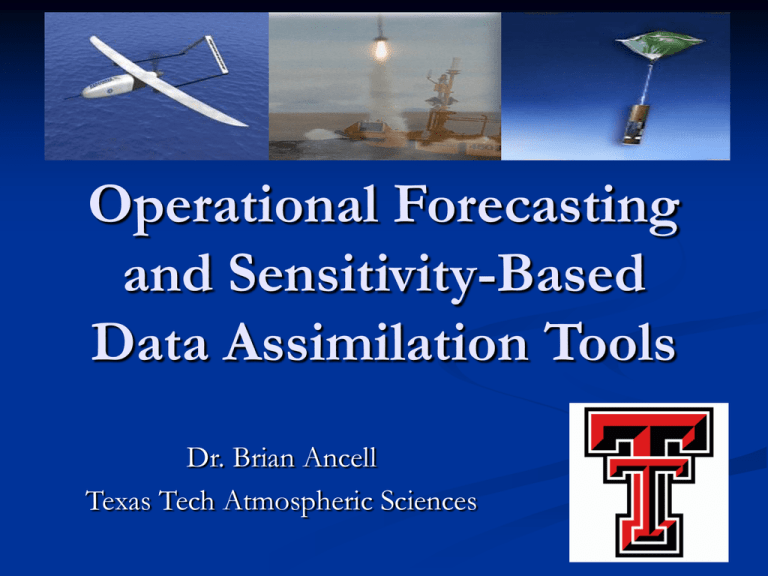
Operational Forecasting and Sensitivity-Based Data Assimilation Tools Dr. Brian Ancell Texas Tech Atmospheric Sciences Operational Forecasting Operational Forecasts can be valuable to a wide range of applications including: - National Weather Service (NWS) day-to-day operations - Transportation - Air quality, forest fire prediction - Wind power Operational Forecasting The following characteristics can make an operational forecasting system substantially more valuable: - Probabilistic - High-resolution Operational Forecasting The following characteristics can make an operational forecasting system substantially more valuable: - Probabilistic - High-resolution The development of a high-resolution, probabilistic real-time modeling system is a major component of my research High-Resolution, Probabilistic Forecasting High-resolution, probabilistic forecasting can be achieved with a Weather Research and Forecasting (WRF) model ensemble Kalman filter (EnKF) High-Resolution, Probabilistic Forecasting High-resolution, probabilistic forecasting can be achieved with a Weather Research and Forecasting (WRF) model ensemble Kalman filter (EnKF) Characteristics of a WRF EnKF - Self-contained data assimilation/forecasting system High-Resolution, Probabilistic Forecasting High-resolution, probabilistic forecasting can be achieved with a Weather Research and Forecasting (WRF) model ensemble Kalman filter (EnKF) Characteristics of a WRF EnKF - Self-contained data assimilation/forecasting system - Flow-dependent data assimilation gives an advantage over other data assimilation systems High-Resolution, Probabilistic Forecasting High-resolution, probabilistic forecasting can be achieved with a Weather Research and Forecasting (WRF) model ensemble Kalman filter (EnKF) Characteristics of a WRF EnKF - Self-contained data assimilation/forecasting system - Flow-dependent data assimilation gives an advantage over other data assimilation systems - Ensemble system -> straightforward forecast probabilities High-Resolution, Probabilistic Forecasting High-resolution, probabilistic forecasting can be achieved with a Weather Research and Forecasting (WRF) model ensemble Kalman filter (EnKF) Characteristics of a WRF EnKF - Self-contained data assimilation/forecasting system - Flow-dependent data assimilation gives an advantage over other data assimilation systems - Ensemble system -> straightforward forecast probabilities - Sensitivity-based adaptive data assimilation tools to improve forecasts How the EnKF Works EnKF mean update equation: Xa = Xb + K * (Y – H(Xb)) Xa = The analysis vector Xb = The forecast (background) vector Y = The observation vector H = Interpolates model to observation site K = The Kalman gain matrix K = B*HT * (H*B*HT + R)-1 B = Forecast error covariance matrix EnKF vs. 3DVAR Temperature observation 3DVAR EnKF Flow-dependence is key! Operational EnKF: Some Results D3 (4km) D2 (12km) D1 (36km) 48-hr mean forecast of sea-level pressure, 925-mb temperature, and surface winds from the operational University of Washington WRF EnKF. Operational EnKF: Some Results COMET Project: 1) Evaluate a multi-scale WRF EnKF 2) Compare operational WRF EnKF surface analyses to current operational NWS surface analysis techniques (RTMA and MOA) Operational EnKF Configuration 80 ensemble members 6-hour update cycle Assimilated observations: - Cloud-track winds - ACARS aircraft temperature, winds - Radiosonde temperature, winds, RH - Surface temperature, winds, altimeter Half of the observations used for assimilation, half are used for independent verification EnKF 36-km vs. 12-km Wind Temperature Improvement of 12-km EnKF Analysis 10% 13% Forecast 10% 10% High-Resolution EnKF Issues Issue #1 - Significant biases exist in the model surface wind and temperature fields Temperature Bias Light Wind Speed (<3 knots) Bias Biases moved around domain during assimilation! High-Resolution EnKF Issues Issue #2 - Too little background variance exists in model surface fields Good observations are neglected! EnKF 12-km vs. GFS, NAM, RUC Wind Temperature RMS analysis errors GFS NAM RUC EnKF 12-km 2.38 m/s 2.30 m/s 2.13 m/s 1.85 m/s 2.28 K 2.54 K 2.35 K 1.67 K South Plains Multi-scale WRF EnKF D3 (2km) D2 (12km) D1 (36km) South Plains WRF EnKF: HighResolution Effects Single, diffuse dryline 12-km Double, tight dryline 2-km Adaptive Data Assimilation Tools with an Operational WRF EnKF Ensemble sensitivity analysis allows the development of data assimilation tools that: 1) Estimate the relative impacts of each assimilated observation (observation impact) Adaptive Data Assimilation Tools with an Operational WRF EnKF Ensemble sensitivity analysis allows the development of data assimilation tools that: 1) Estimate the relative impacts of each assimilated observation (observation impact) 2) Estimate the impact of additional, hypothetical observations (observation targeting) What is Ensemble Sensitivity? Basic recipe for ensemble sensitivity: An ensemble of forecasts (via the EnKF) 2) Response function (J) at some forecast time 1) Ensemble sensitivity is the slope of the linear regression of J onto the initial conditionsSlope = ∂J/∂Xo J To What is Ensemble Sensitivity? Basic recipe for ensemble sensitivity: An ensemble of forecasts (via the EnKF) 2) Response function (J) at some forecast time 1) Ensemble sensitivity is the slope of the linear regression of J onto the initial conditionsSlope = ∂J/∂Xo Examples of J - Dryline strength, position - Wind power J To Impact of Hypothetical Observations J = 24-hr cyclone central pressure L L Pa^2 1st Observation 2nd Observation EnKF Adaptive Data Assimilation Tools The application of sensitivity-based data assimilation tools can answer these important questions: 1) Where should we take observations to best forecast high-impact weather? EnKF Adaptive Data Assimilation Tools The application of sensitivity-based data assimilation tools can answer these important questions: 1) Where should we take observations to best forecast high-impact weather? 2) Are the most effective observations adaptive or routine? EnKF Adaptive Data Assimilation Tools The application of sensitivity-based data assimilation tools can answer these important questions: 1) Where should we take observations to best forecast high-impact weather? 2) Are the most effective observations adaptive or routine? Current Work - Severe convection, winter weather, flooding (NOAA CSTAR, in review) - Short-term wind forecasting (DOE)
